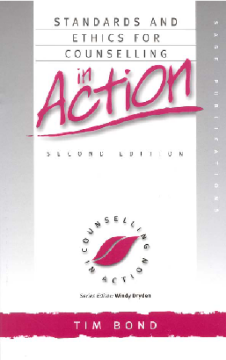
Additional Information
Book Details
Abstract
In Paise of the First Edition...
`Essential reading for therapists, counsellors, supervisors, trainers and health care workers... It is a book which will help us all to guard the high professional and ethical standards to which responsible workers aspire, and which all our clients are entitled to expect' - British Journal of Guidance & Counselling
`Highly recommended. Essential on every counselling course reading list as well as on counsellors' own bookshelves' - Counselling, The Journal of the British Association for Counselling
This highly acclaimed guide to the major responsibilities which trainees and counsellors in practice must be aware of be
`This edition retains the same informative and accessible style and broadly the same order of contents as the First Edition, which makes it easy for readers to track down key changes. The author's extensive experience in the field of ethics in counselling and his experience as Chair of BACP underpin this updated, essential and authoritative Second Edition' - British Journal of Guidance & Counselling
'Tim Bond has done a great service to the counselling profession by writing, and now updating, this book… His particular strength must surely be his clarity in acquainting counsellors with the complexities of British law. After an introduction, he starts with an exploration of the origins and scope of counselling. He then exemplifies cases in which a counsellor's personal and professional values collide. He has collected together a host of ethical dilemmas that counsellors might have to face' - Naomi Stadlen, Journal of the Society for Existential Analysis
Table of Contents
| Section Title | Page | Action | Price |
|---|---|---|---|
| 1. Introduction 1 | |||
| 2. Acknowledgements 2 | |||
| 3. Overview | |||
| 1. Choice of Technology 3 | |||
| 1. Policy Issues 3 | |||
| 2. Physical and Technical Issues 4 | |||
| 2. Situation Analysis - Impact, Adoption & Diffusion 6 | |||
| 3- The Technology of Animal Draught Use 8 | |||
| 1. Tillage Techniques, Implements and Harnessing 8 | |||
| 2. Draught Capacity, Training, Nutrition and | |||
| General Management 10 | |||
| 4. Bibliography | |||
| 1. Choice of Technology 12 | |||
| 2. Situation Analysis 28 | |||
| '5. Technology of Animal Draught Use 42 | |||
| 3.1 Tillage Techniques, Implements and Harnessing 42 | |||
| 3.2 Draught Capacity, Training, Nutrition and | |||
| General Management 59 | |||
| 4. General 73 | |||
| 5. Conclusion |
